Review by James Bacon

“Heroes” currently running at the Cartoon Museum in London until October, offers a stunning selection of comic art, with many exceptional pieces, as visitors follow the history of comics and the convergence of US and UK comics, commercially and artistically and we see how British artists and writers became so important and prominent and their brilliance appreciated.
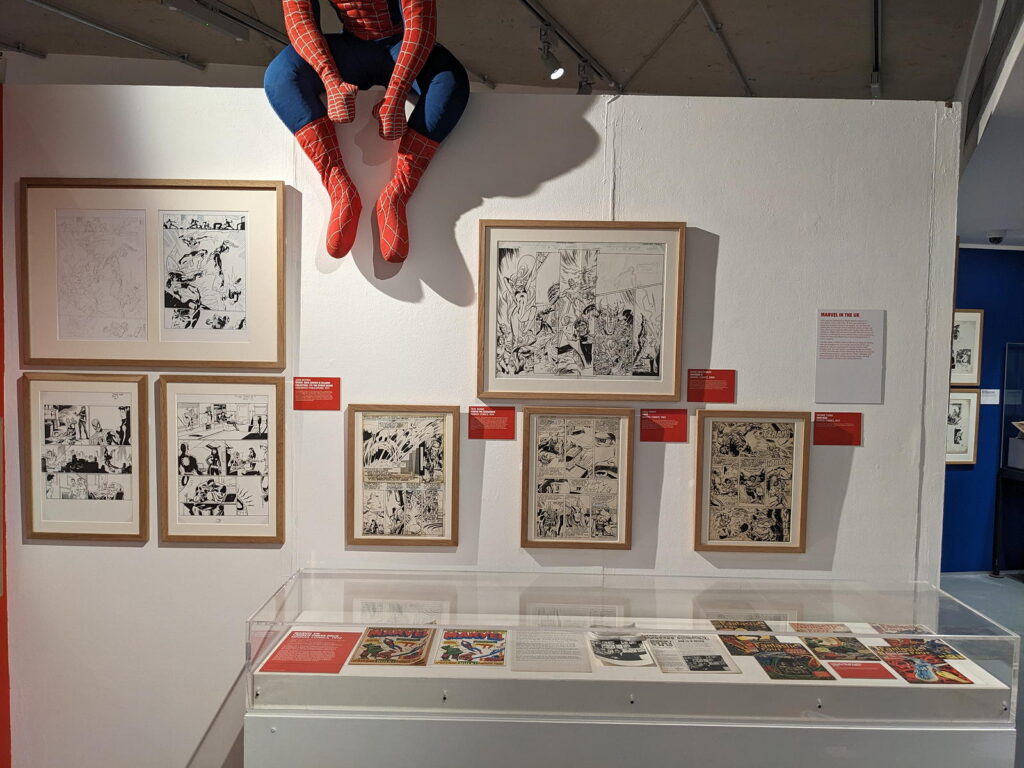
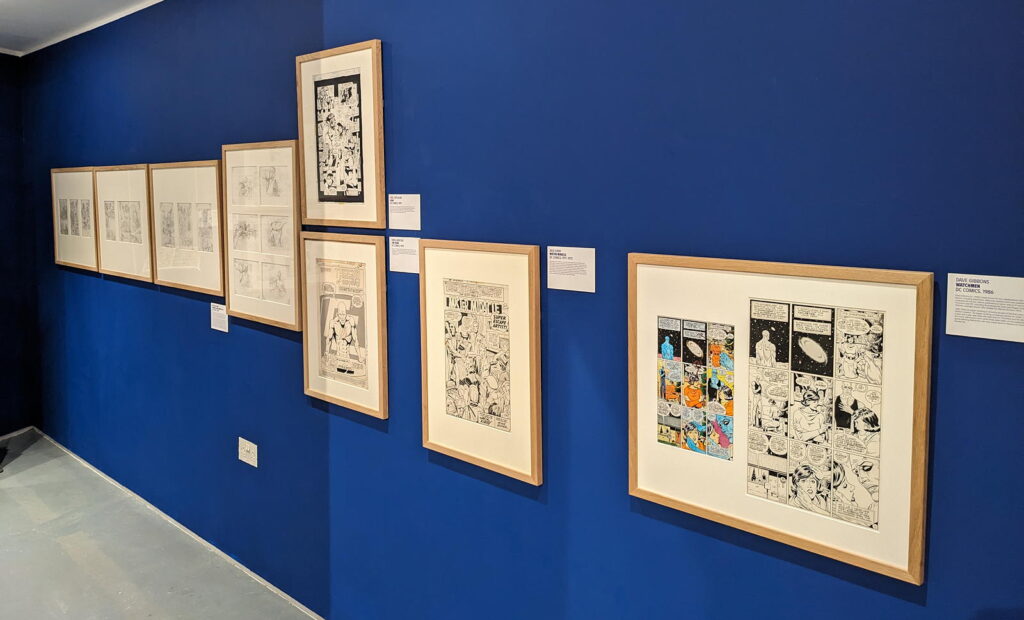
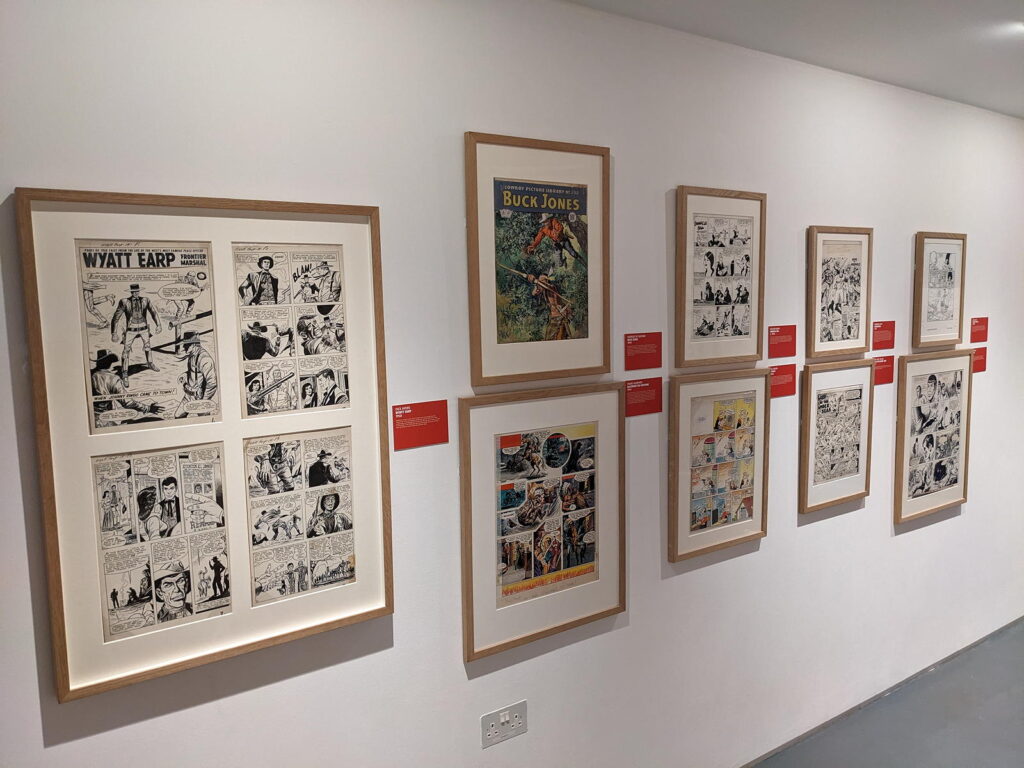
This is a really interesting and thought-provoking exhibition, which takes a long look at the industry. It starts by contrasting American and British comics, with some amazing American newspaper full-page “cartoon stories” that are lovely to see, one hundred and twenty years after publication and, astonishingly, include original hand-painted art. The page of “The Yellow Kid” contrasts with the “Buster Brown” original piece by Richard F. Outcault. Then we have a 1908 page of Winsor McCay‘s “Little Nemo in Slumberland” – surreal and inventive, and so bright and colourful.


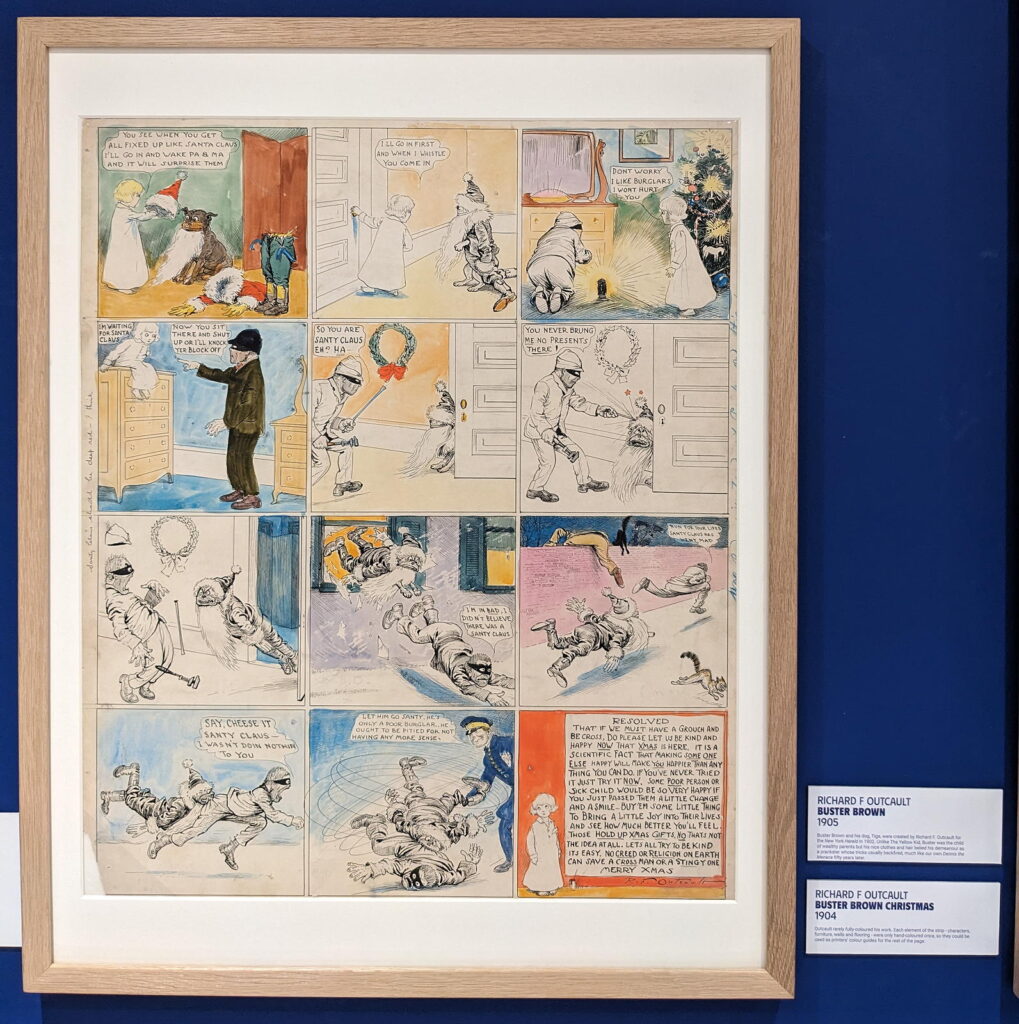
These newspapers are fascinating. As we continue into the 1930s one can see and read Hal Forrest’s “Tailspin Tommy” in its original painted form, newspapers with “Felix the Cat” by Otto Messmer, and Harold Gray‘s “Little Orphan Annie”. One can contrast the latter with the Daily Mirror’s “Belinda Blue-Eyes”, which began in 1936, who the Museum describes as “a homeless waif, [that] was clearly an imitation of Annie, even down to her blank white eyes”.

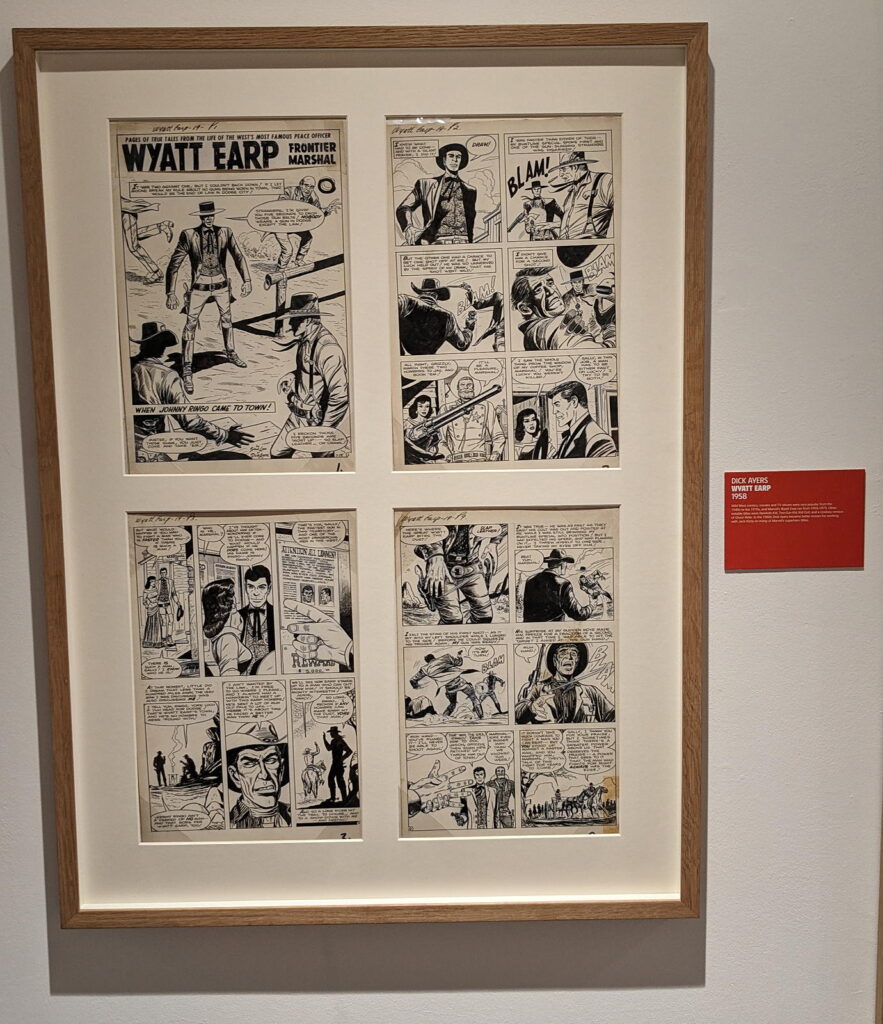
The Museum has grouped comics, so we have a page of Alex Raymond’s “Flash Gordon” and Dick Calkin’s “Buck Rogers” from the 1930s next to Hal Foster’s “Prince Valiant” from 1942. Alongside these, we see selections from the Museum’s vaults which showcase Hal Foster’s working process, with script and thumbnails, in the later years of “Prince Valiant”, when he ceased drawing and collaborated with John Cullen Murphy.
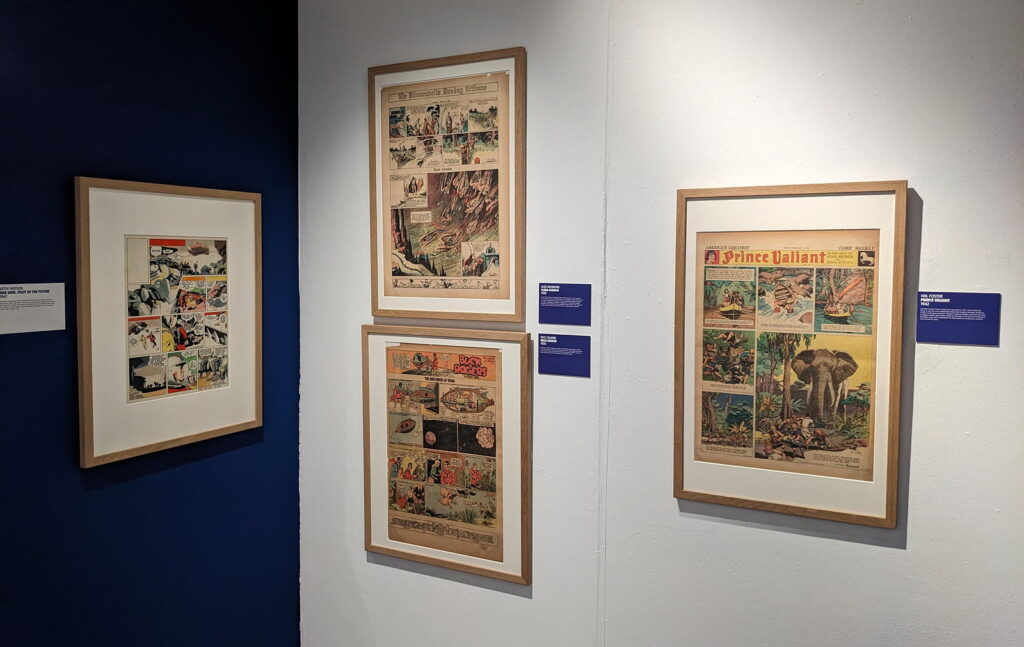
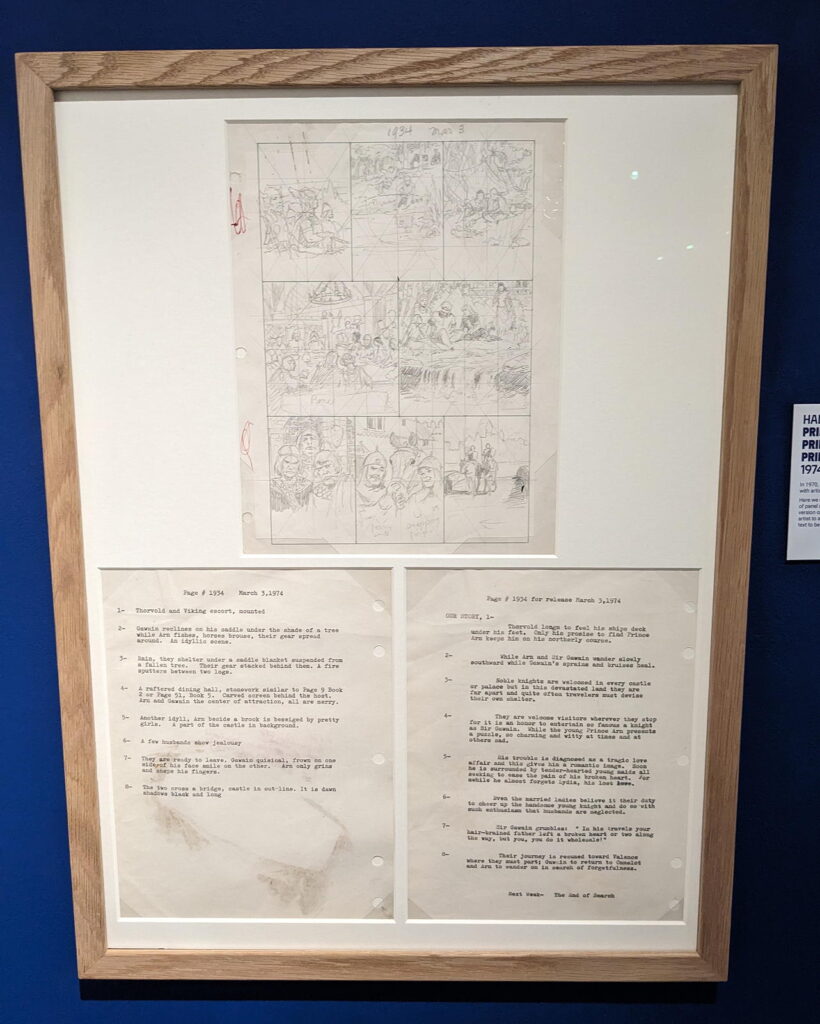
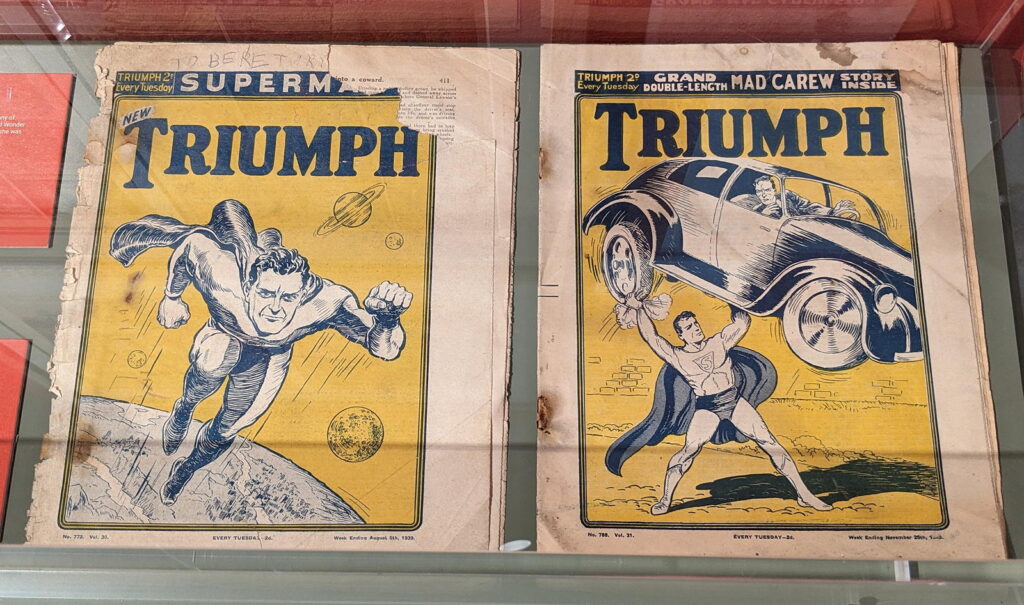
Pages of “Miss Fury”, created in 1941 by June Tarpé Mills, which are an absolute delight to see, are hung next to Superman and Batman. These in turn contrast with the British publication, Triumph, from 1939. Two issues are featured here, which reprinted Superman newspaper strips a year after the superhero’s debut, and are fine demonstrations of early licensing and reformatting as well as adaptation. John ‘Jock’ McCail drew occasional introductory half-pages, as well as the covers for this story paper. The amount of American material that is made available for the UK market increases considerably. To show this, the Museum continues to show US comics by the hand of British artists, an original page of “Binnacle Bill” by William Ward contrasts with a “Popeye” page by British artist Bill Mevin, as well as comics from the UK that had been influenced by American superheroes, such as Lord of the Under-Seas by Jock McCail and Marvelman by Norman Light.
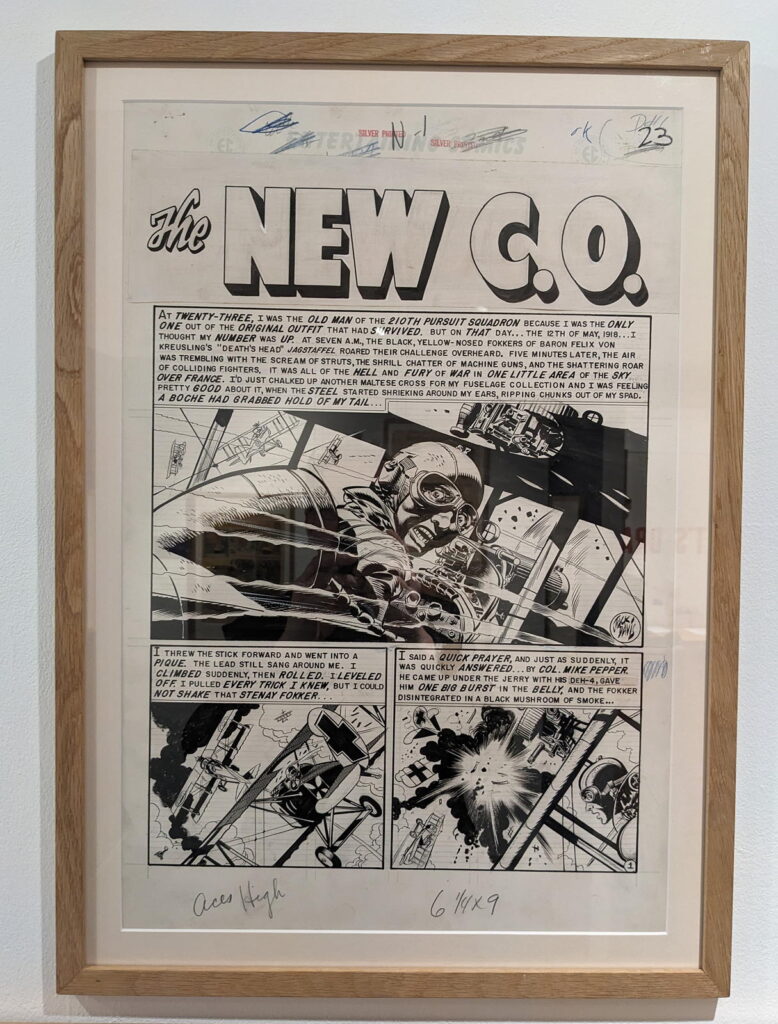
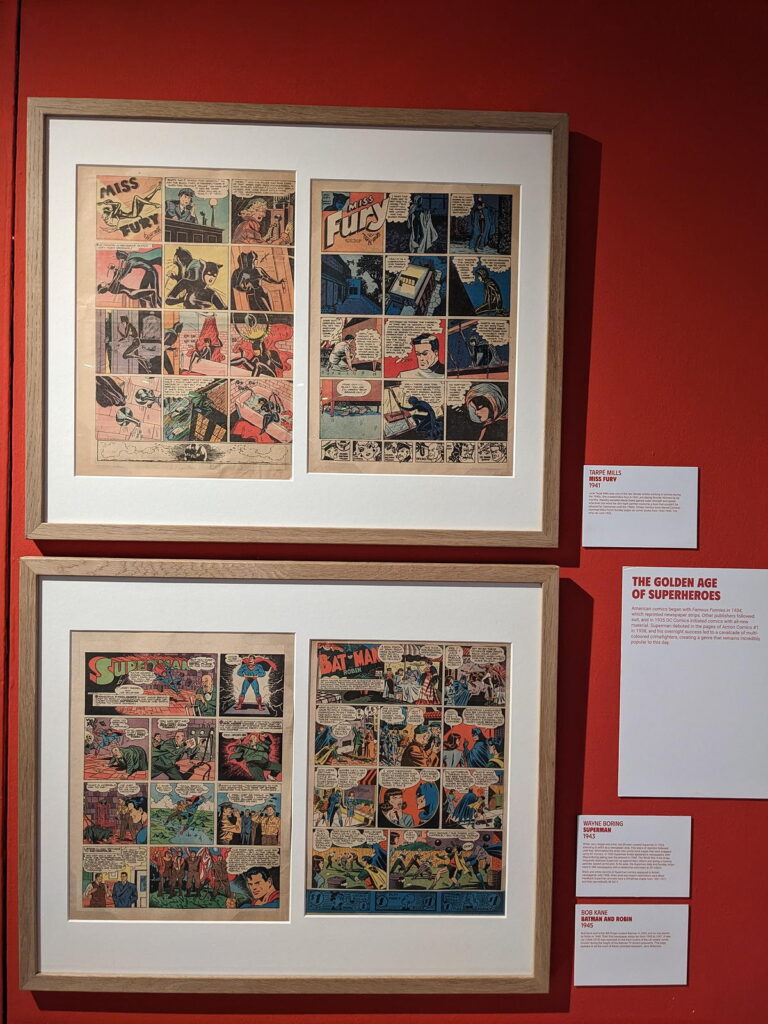
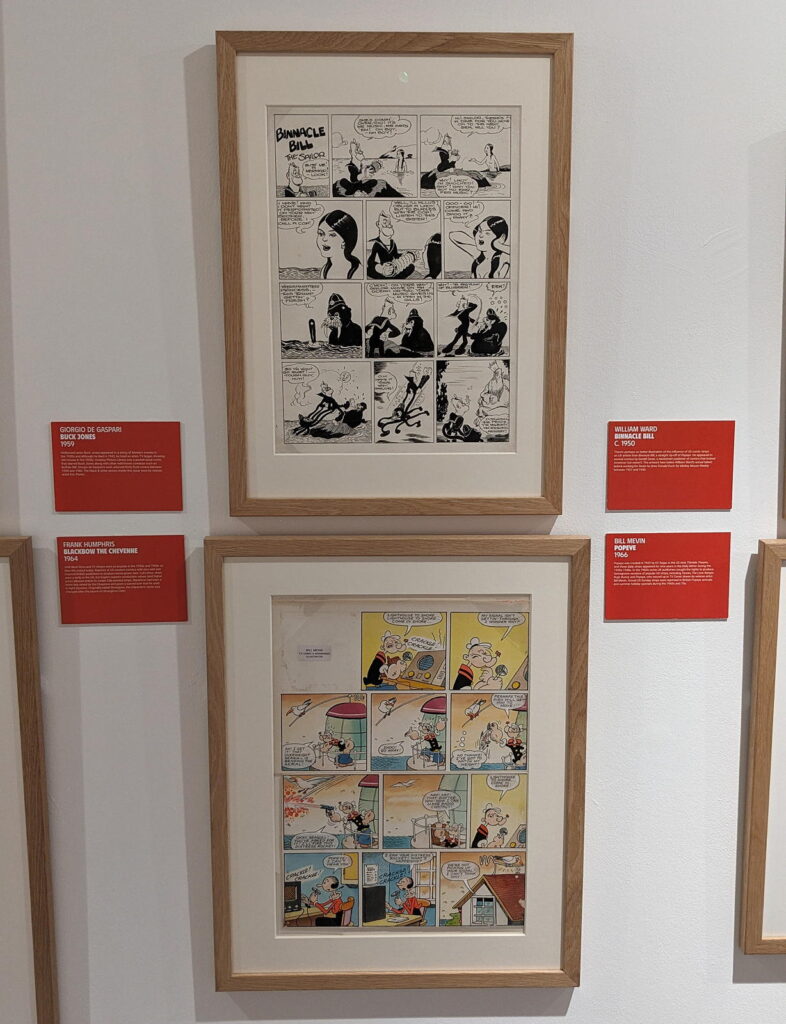
There is then a subtle change to the exhibition. First, we have Batman work by John Leeder, which featured in the British-published Batman Story Book Annuals from 1967 to 1970, which accompanied original text stories. This portion of the exhibit leads to a wall of Batman pencils by Brian Bolland.
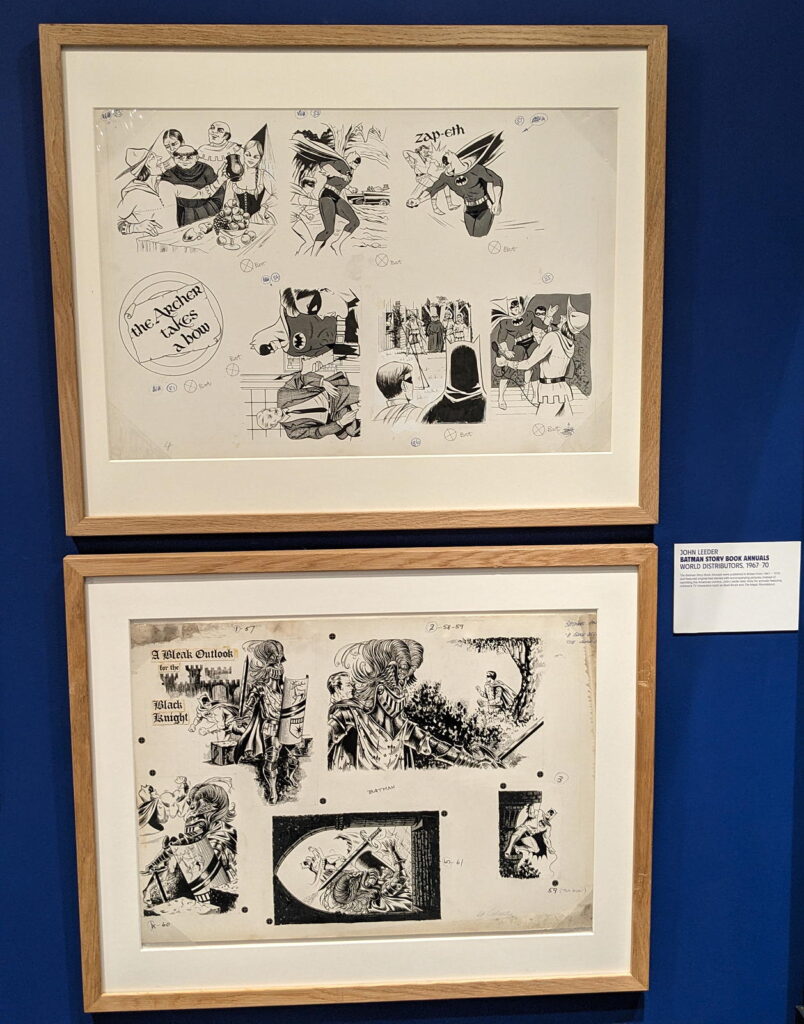
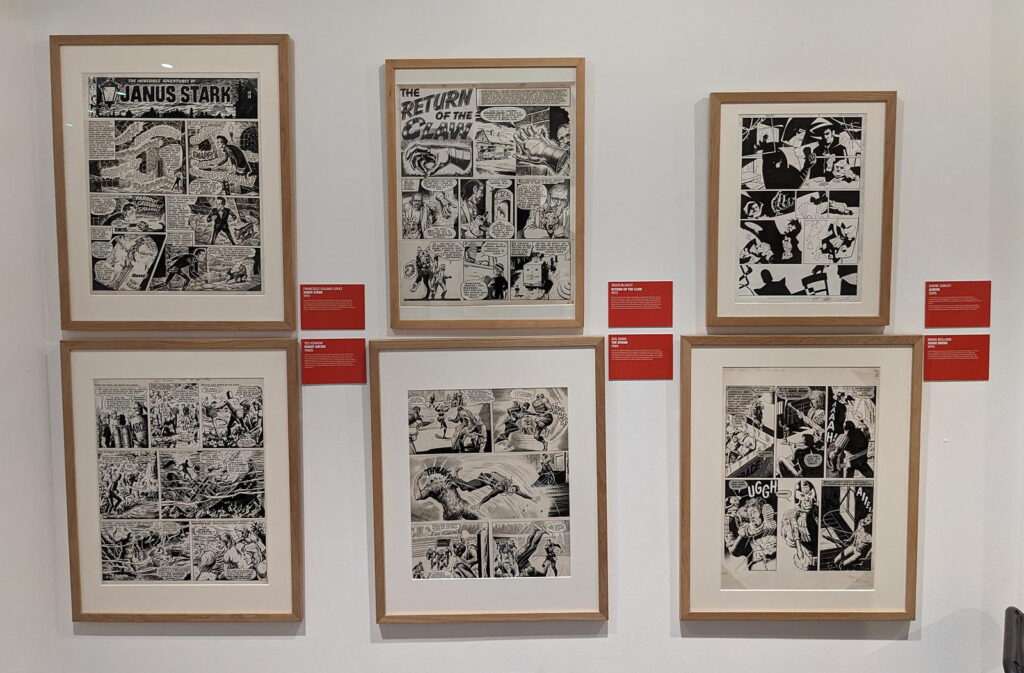
Bolland was one of many creatives who worked on the Batman #400 anniversary issue in 1986, which contained an introduction by Stephen King, a page by John Byrne, eleven chapters, each by different artists, and an epilogue. “Resurrection Night”, written by Doug Moench, saw Ra’s al Ghul release prisoners from Gotham Prison and inmates from Arkham Asylum, and a cavalcade of well-known adversaries chase after the bounty that is placed on Batman’s life. Chapter 11, the showdown between Batman and Ra’s al Ghul, was Bolland’s chapter. Here on the wall of the Cartoon Museum are the original penciled draft layouts for twelve pages. It is amazing to see both the details and the occasional change.
In the pencils on Page 54, in the 3rd Panel, Ra’s al Ghul charges towards Batman, but in the comic, this panel shows Batman standing, with Ra’s Face in the foreground, and Batman goading Ra’s. On page 55 of the pencils, there is a blank space in the 4th panel. Accompanying the 12 pages are six draft panels, including the changed panel for page 54 and the panel that would go into the blank space on Page 55, an incredible insight into the artistic process and the meticulous detail that is Brian Bolland’s work.
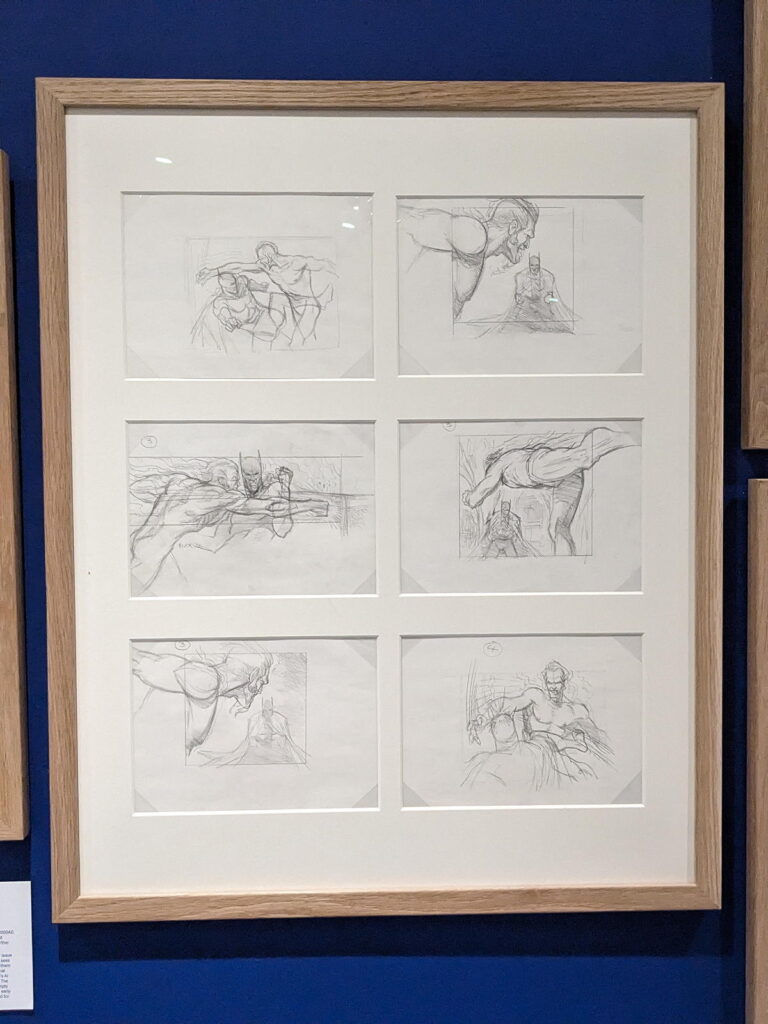
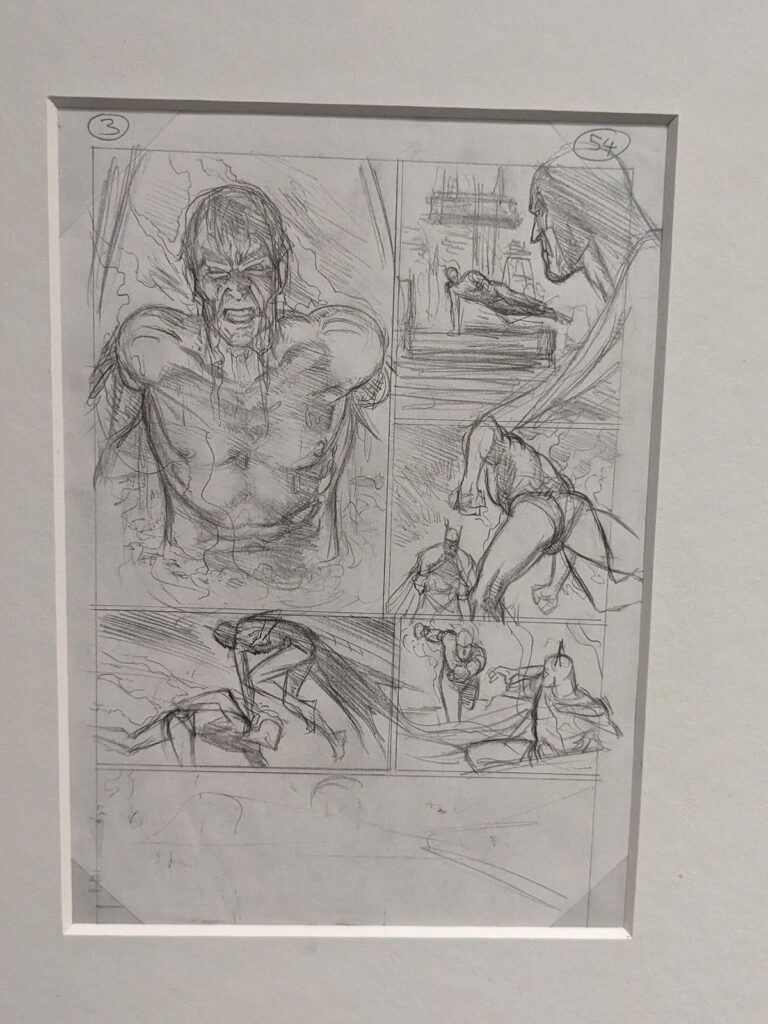

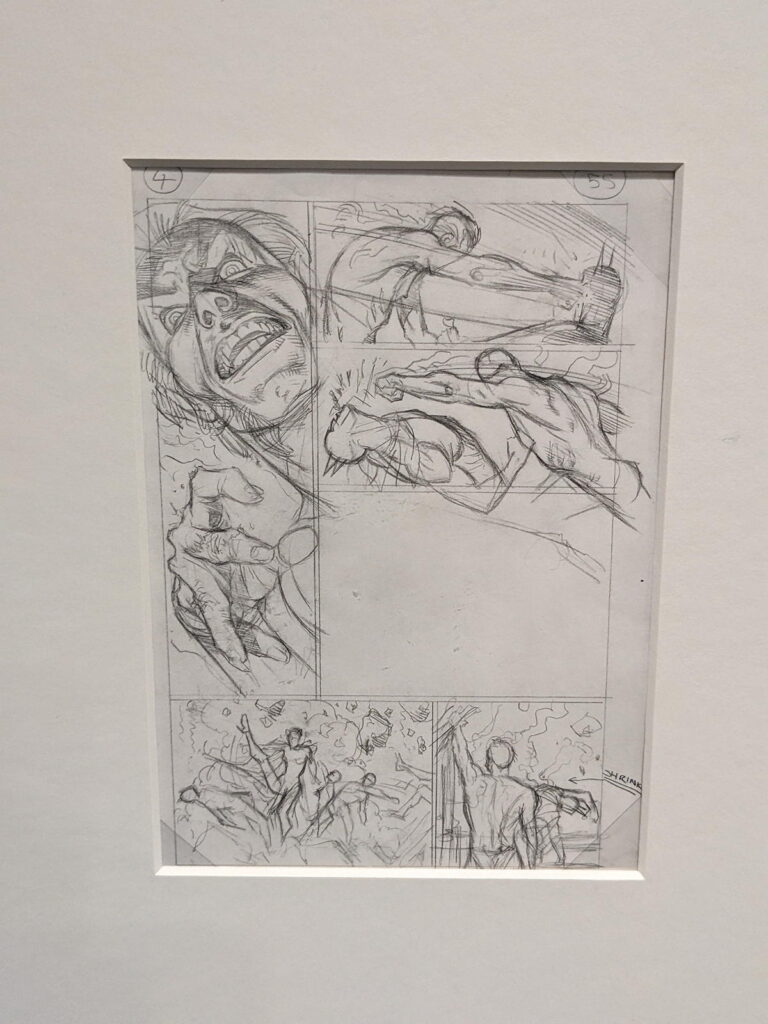
Brian was at the vanguard of the “British Invasion”, starting with Green Lantern #127 in April 1980. Given that he wrote a dissertation on Neal Adams in 1973, he is a fine demonstration of the appreciation that British creatives had for US comics creatives.
I am mindful of the influence Marvel and DC obviously had, and of course British comics Wham!, Smash! and Pow! from Odhams Press republished Marvel and DC stories alongside homegrown adventure and humour strips, starting with The Incredible Hulk in May 1966, in Smash. Soon, Fantastic and Terrific joined the Odhams ranks, but this intensity was short-lived. 1967 and 1968 must have seemed quite exciting, but mergers followed quickly. Pow! ran for 86 issues, Terrific for 43 issues and Fantastic for 89, all three ending in 1968, and while Wham! continued a little longer, and the licensing rights were handed back.
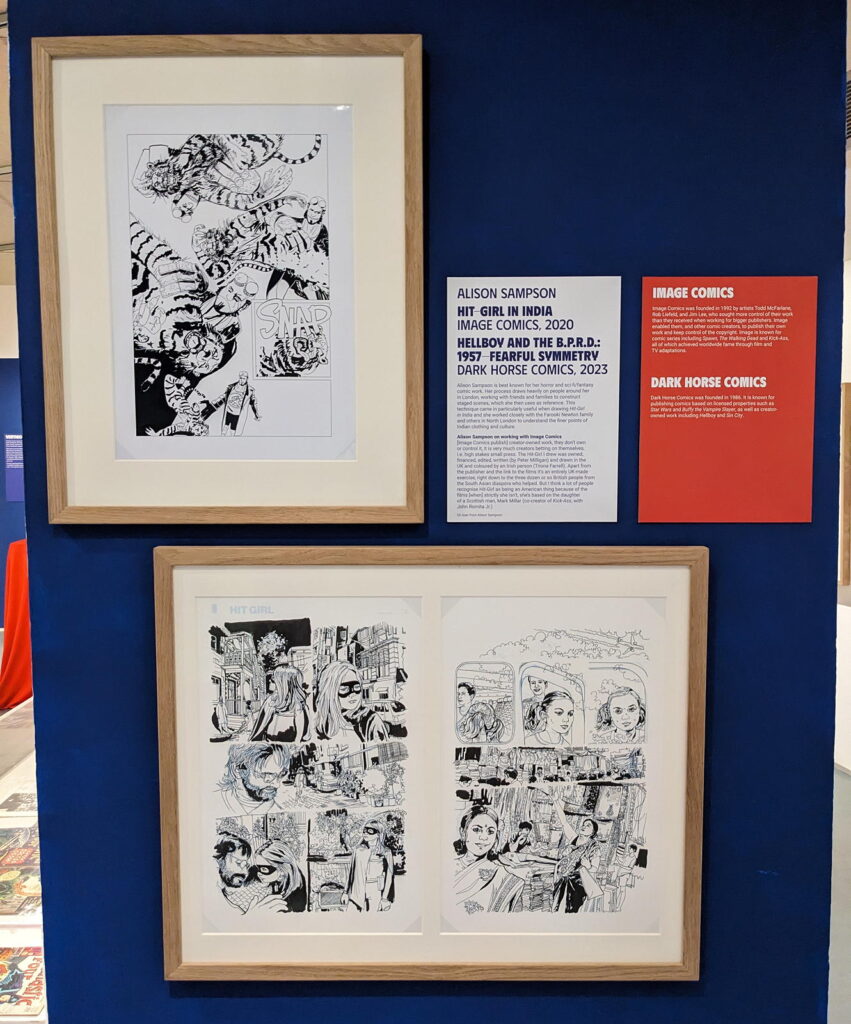
As one turns around, yoou’re confronted by pages of Alison Sampson art from Hit-Girl in India, and Hellboy and the B.P.R.D. 1957 Fearful Symmetry, and the museum explains that Sampson’s “process draws heavily on people around her in London, working with friends and families to construct staged scenes, which she then uses as reference. This technique came in particularly useful when drawing Hit-Girl in India and she worked closely with the Farooki Newton family and others in North London to understand the finer points of Indian clothing and culture.”

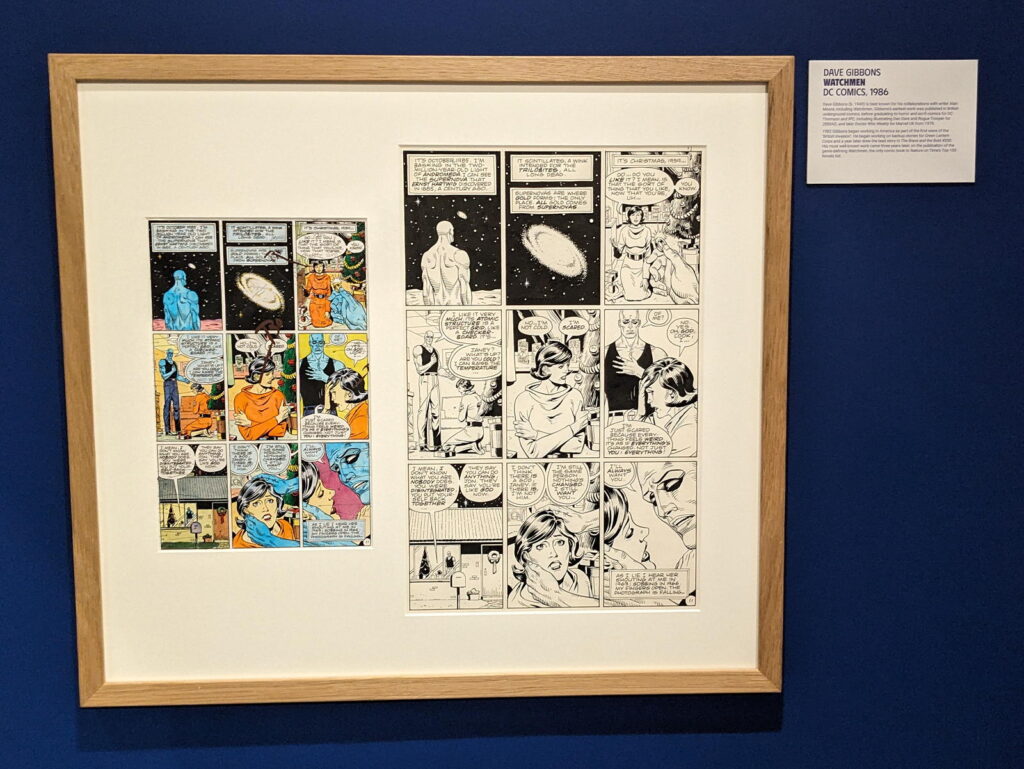
The calibre of original art continues apace: a Jack Kirby page of Mister Miracle sits next to Page 11 from Watchmen #4 by Dave Gibbons with a colour proof. Gibbons was a friend to Brian Bolland, recommending an agency and working together on Powerman, a British comic distributed and for the Nigerian market in 1975. I would love to say that Gibbons, like Bolland, had Green Lantern as his first published work in the US, but it was a close second. Green Lantern #161, with a February 1983 cover date and a Dave Gibbons back up story, was released on the 26th of October 1982, while Flash #318, also with a back-up story by Gibbons, was allegedly published on the 19th of October. Seeing their art, up close and enjoying it, is such a pleasure.
A very unusual set of items, the Marvel UK launch press pack from 1972 is also on display. This includes a Mighty World of Marvel #1 signed by Stan Lee, a print of the cover, a Stan Lee biography and promotional photograph and nicely, issue #4 of the Fantasy Domain fanzine,with an interview with Stan Lee by Rob Barrow.
The museum notes the importance of women in the industry, as well. The first editor of Mighty World of Marvel was Pippa M. Melling, succeeded by another woman, Peta Skingley, then Maureen Softley in 1974, showing the key role that women played in setting up and editing Marvel UK was obscured due to the use of pseudonyms.
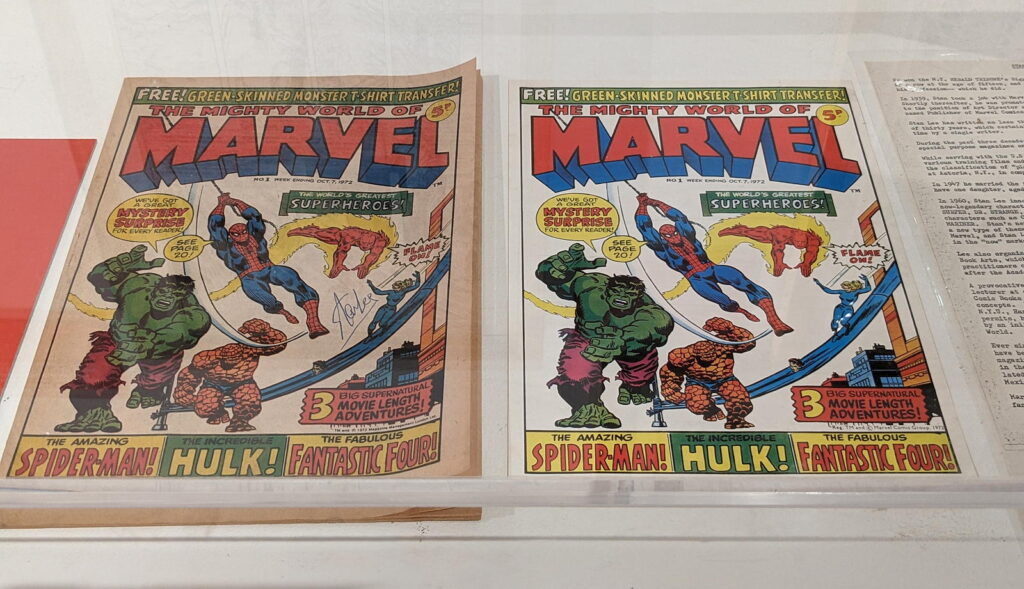
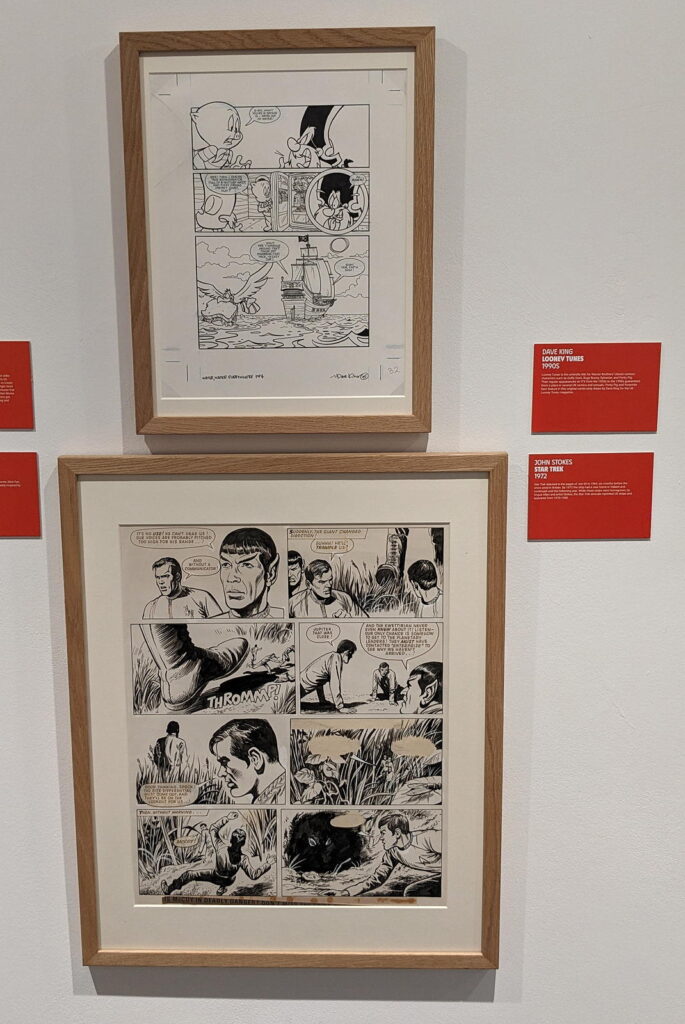
The incredible original art continues: a Herb Trimpe page of Thor, Doug Braithwaite Universe X pages, John McCrea‘s Spider-Man: Heroes and Villains from Eaglemoss, a licensed weekly magazine sold in the UK that included an original seven-page story in every issue set in an alternative universe, Rachel Stott’s Fantastic Four pages, and, finally, another Bolland, a page from 2000AD‘s “Judge Dredd“.
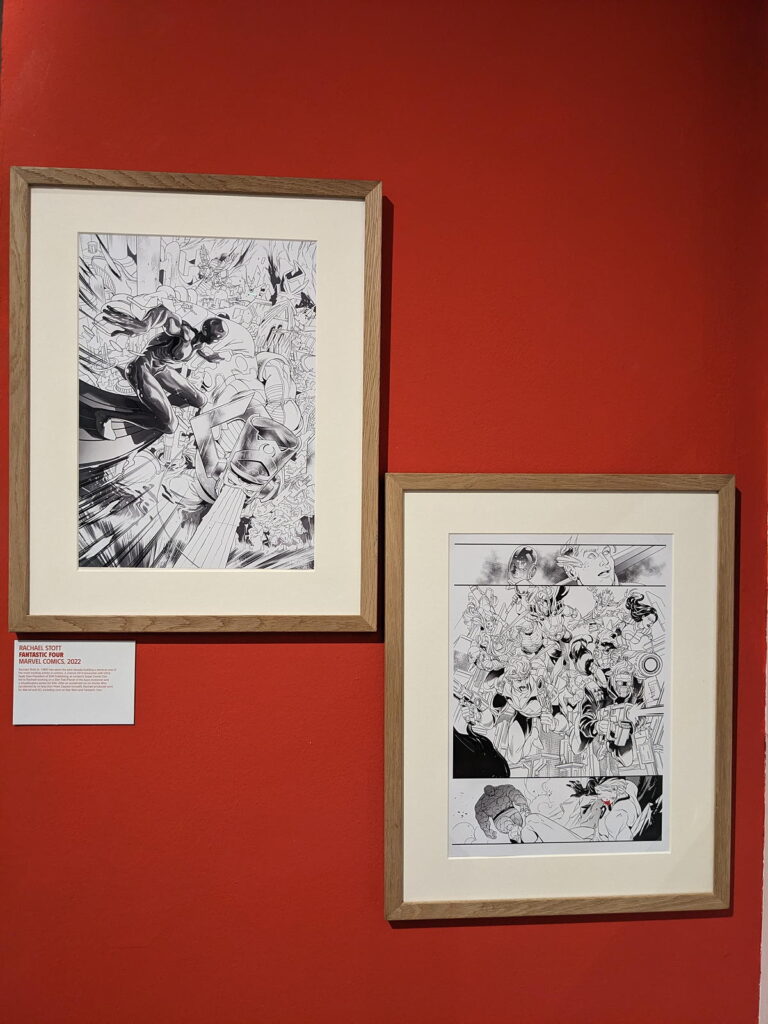
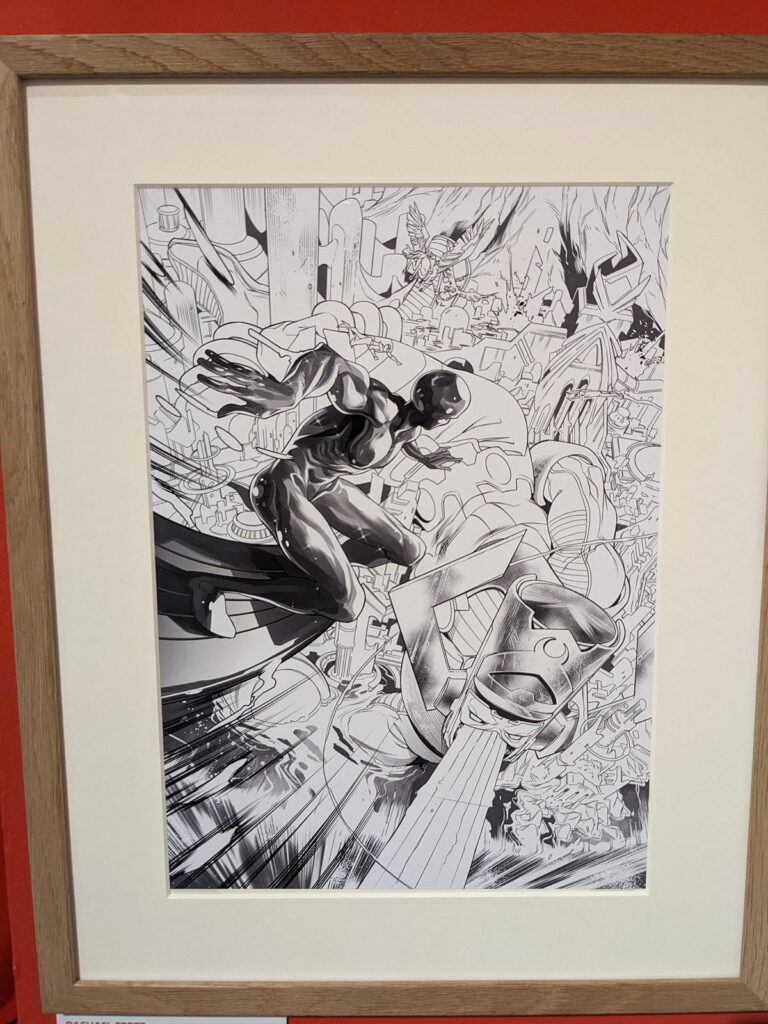

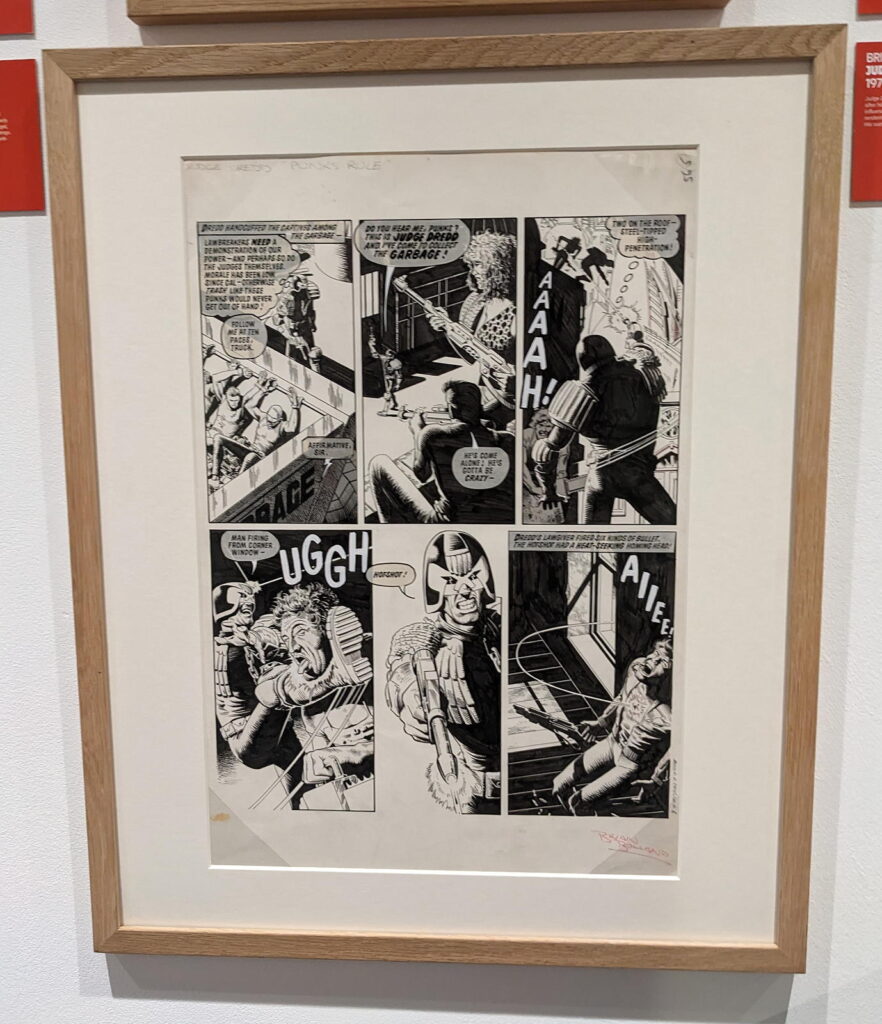

While the British Invasion of the US occurred in the 1980s, many of the most well-known had experienced or worked on Marvel UK comics. Paul Neary, Alan Moore, John Higgins, Dave Gibbons, Alan Davis, David Lloyd and many others. Brian Bolland’s and Davie Gibbon’s incredible art in the vanguard was complemented by Alan Moore‘s writing, who began his own US comic career in 1983 with The Saga of the Swamp Thing #20 (cover dated 1984), famously following this up with Watchmen (1986-1987) and Batman: The Killing Joke (1988).
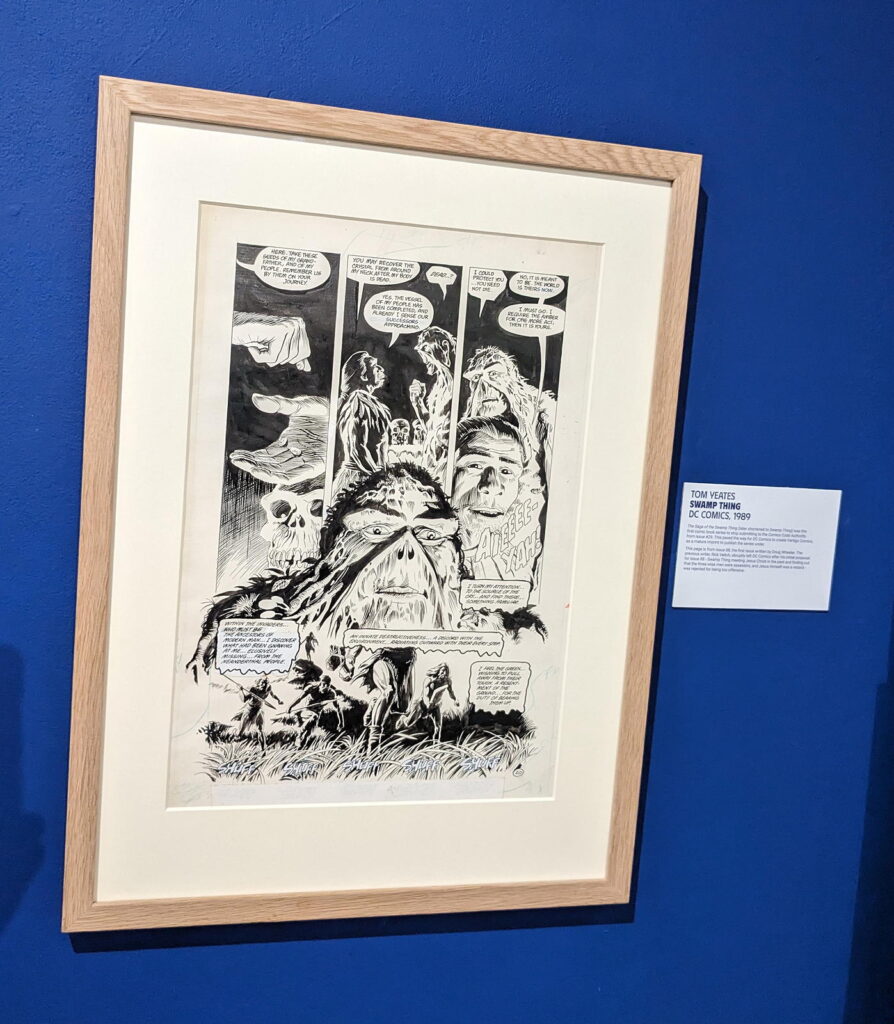
Karen Berger is also noted as key to the British Invasion, and the exhibition starts to look at the comics that were mature and more nuanced. Neil Gaiman followed Alan Moore, and there is no shortage of original art to complement the story being told by the Museum.
An original page of Doom Patrol art by Richard Case highlights the work that Grant Morrison was doing, including Animal Man, which had stunning Brian Bolland covers. We see a striking Duncan Fegredo page of Enigma, written by Peter Milligan, who, like Morrison, had worked on Animal Man. Both comics are used to make mention of the addition of diversity to comic line-ups and the museum goes into detail here, sharing important nuances and clearly progressive positions when they occur. The Museum also has some more Brian Bolland original sketches, unpublished workings for the cover of Animal Man issue #11, visible here for all to enjoy.
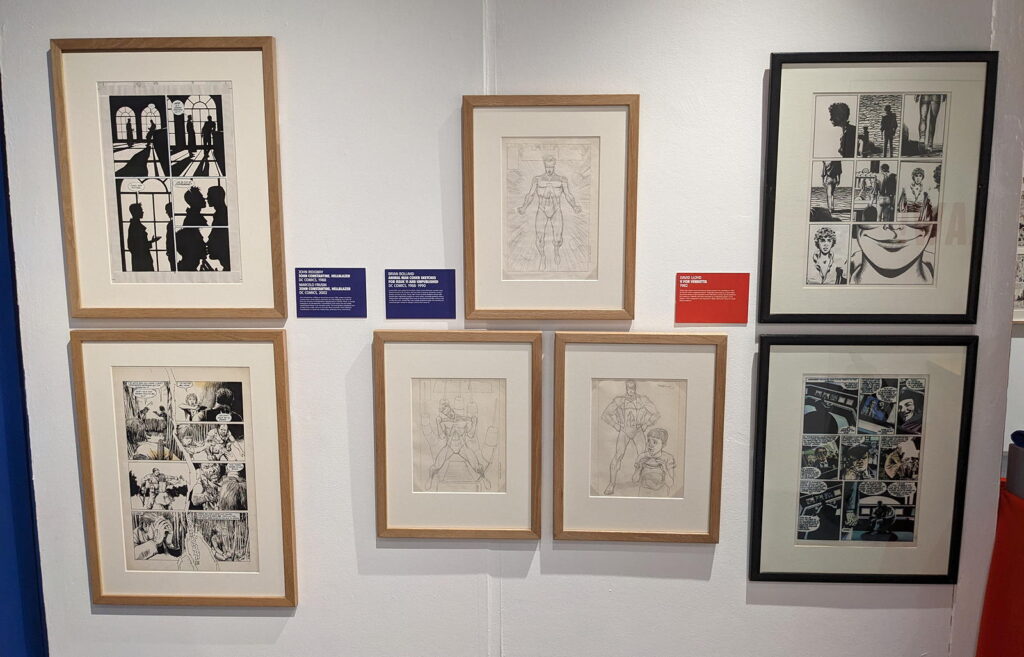
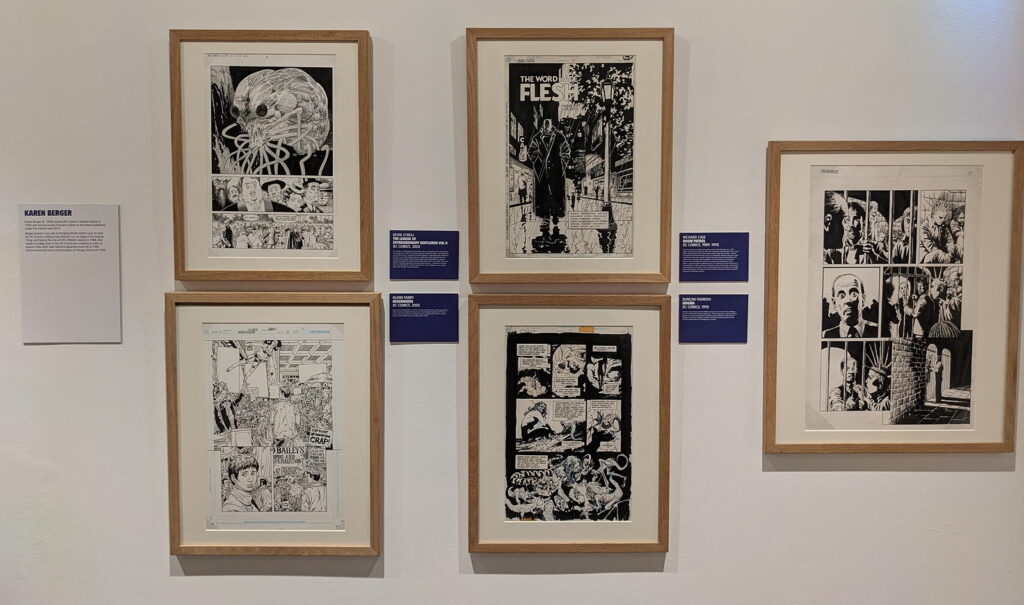
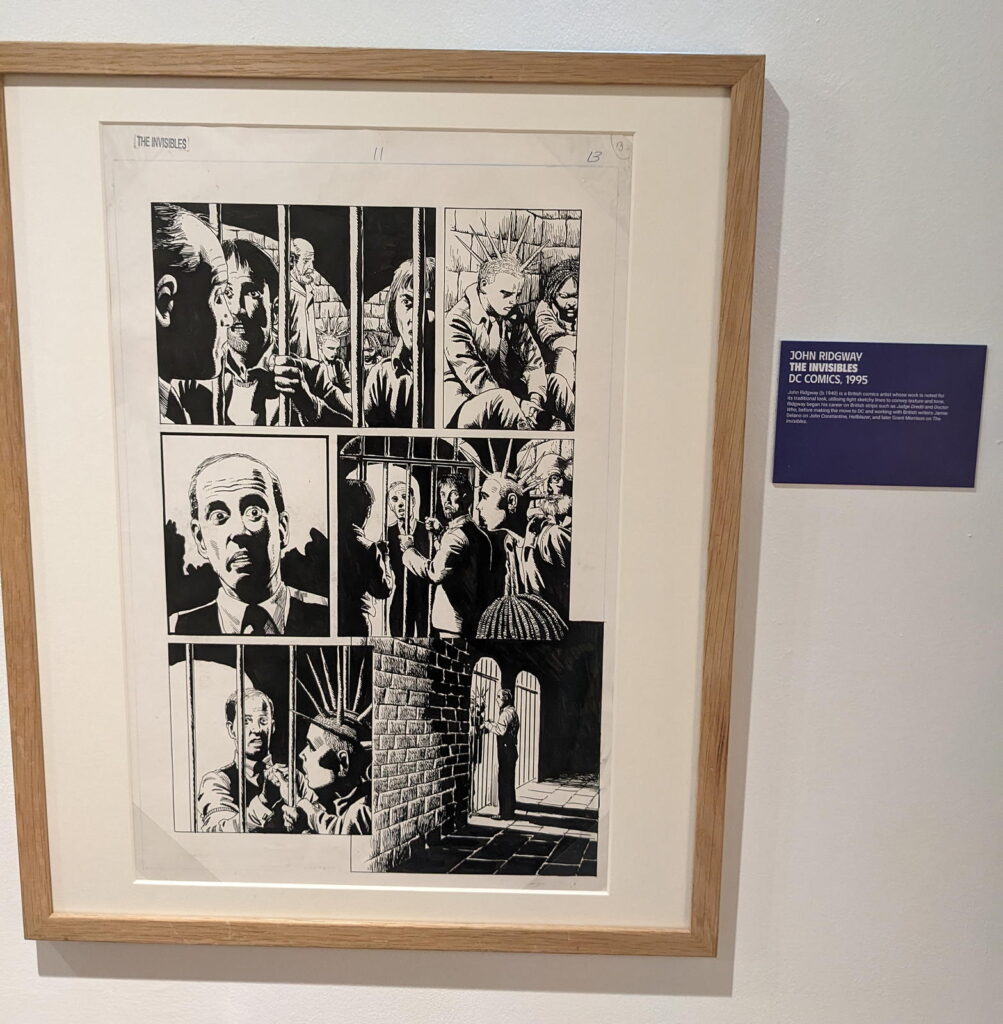

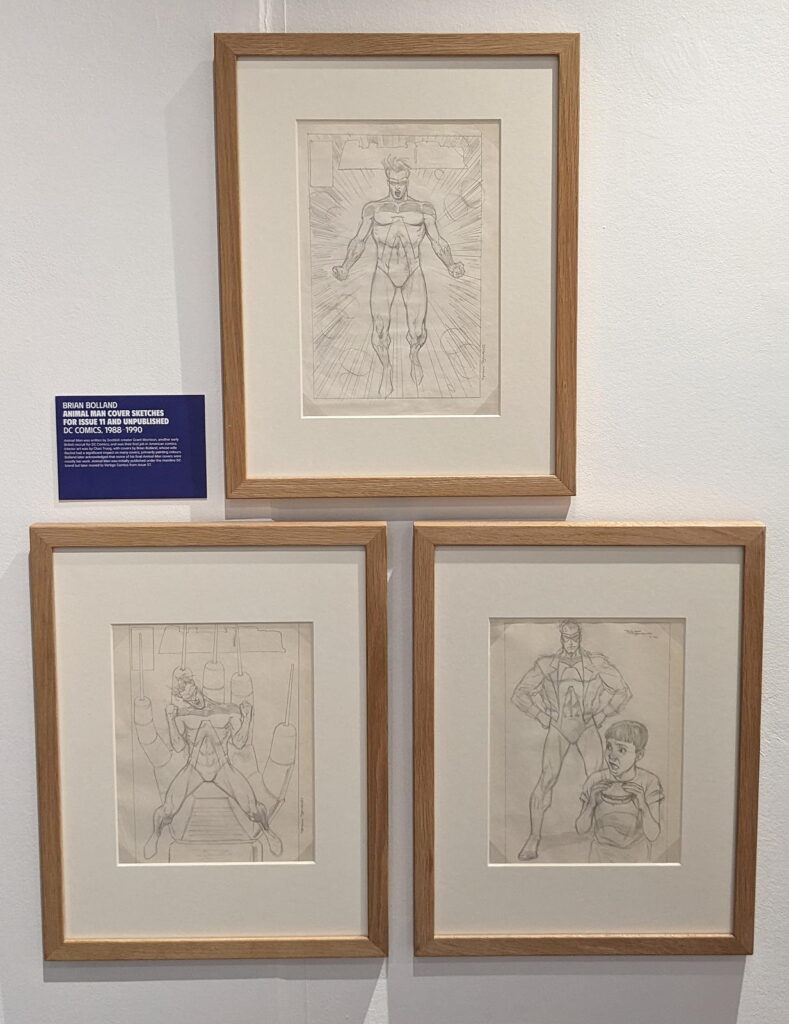
There were so many exciting and interesting comics at this time from British writers and artists: Neil Gaiman and Dave McKean‘s Black Orchid, Peter Milligan, Steve Dillon, and Brett Ewins on Skreamer, Cam Kennedy on The Light and Darkness War with Tom Veitch, and Pat Mills and Kevin O’Neill on Marshall Law. John Wagner and Alan Grant worked on Batman, and with Cam Kennedy on Outcasts. Grant seemed to find success with Batman and of course, Lobo, of which there is a page on display.
John Constantine, created by Alan Moore, Steve Bissette and John Totleben, who first appeared in Swamp Thing #37 in 1985, is well represented here, with original artwork by John Ridgway and Marcelo Frusin. This is a comic that many from this side of the Atlantic have worked on: Jamie Delano, Dave McKean, Garth Ennis, Will Simpson, Steve Dillon, Peter Milligan, Simon Bisley, Mike Carey, Denise Mina…the list goes on. Hellblazer, along with Sandman, was a defining comic of the Vertigo era, changing branding, separating themselves somewhat from the rest of the DC-verse. This is a hugely rich era of comic book history.
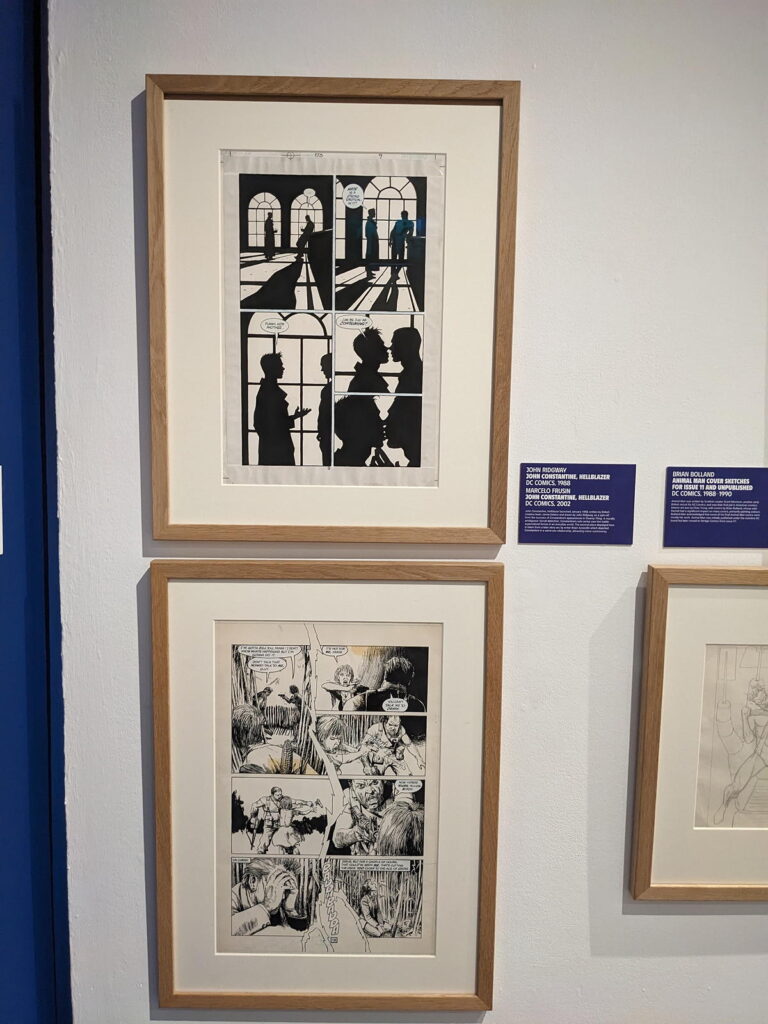
Two original pages of V for Vendetta by David Lloyd and Alan Moore (created in 1982 for the UK comic Warrior) end this part of the exhibit, a fine way to do so. The convergence, development, cross pollination, and importation is nicely bookended with these pages, showing how America in 1988 was importing British comic work.
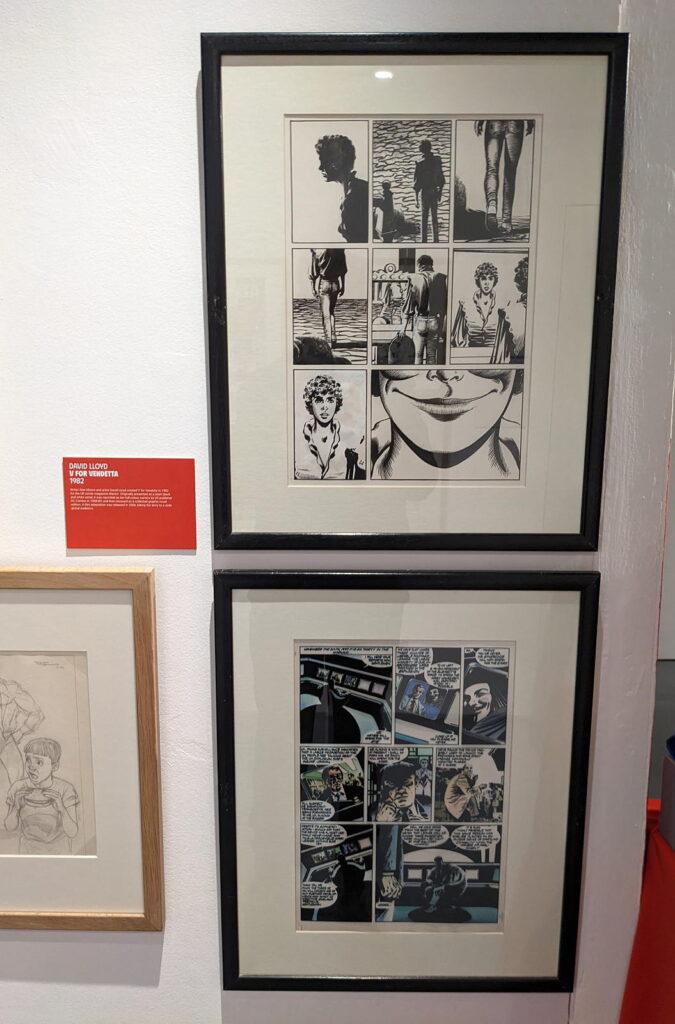
There are then some very interesting pieces. Daniel Egharevba is a Nigerian artist based in Lagos, working with writer Oluwasegun Baba Babatunde, a Nigerian writer based in Warrington. They have worked to reflect their experiences and perception building on West African mythology and design to create a comic character, and so we have a beautiful piece from Olórò, the Grandson of Fádèyí Olóró (There’s more information here on the Cartoon Museum blog).
This is joined by Road Knight by Shane Melisse, a fascinating perception of London, combining superheroes with Dark Fantasy, in a more realistic fashion or relative to the 21st Century, pointing to the future for the genre and sharing with the viewer that new futures exist.
This is a large exhibition. So much has been made available, and it is clear that there is a rich seam of original comic art to be shared with the public. Complementing the exhibit are displays for children, a drawing area, costumes etc.
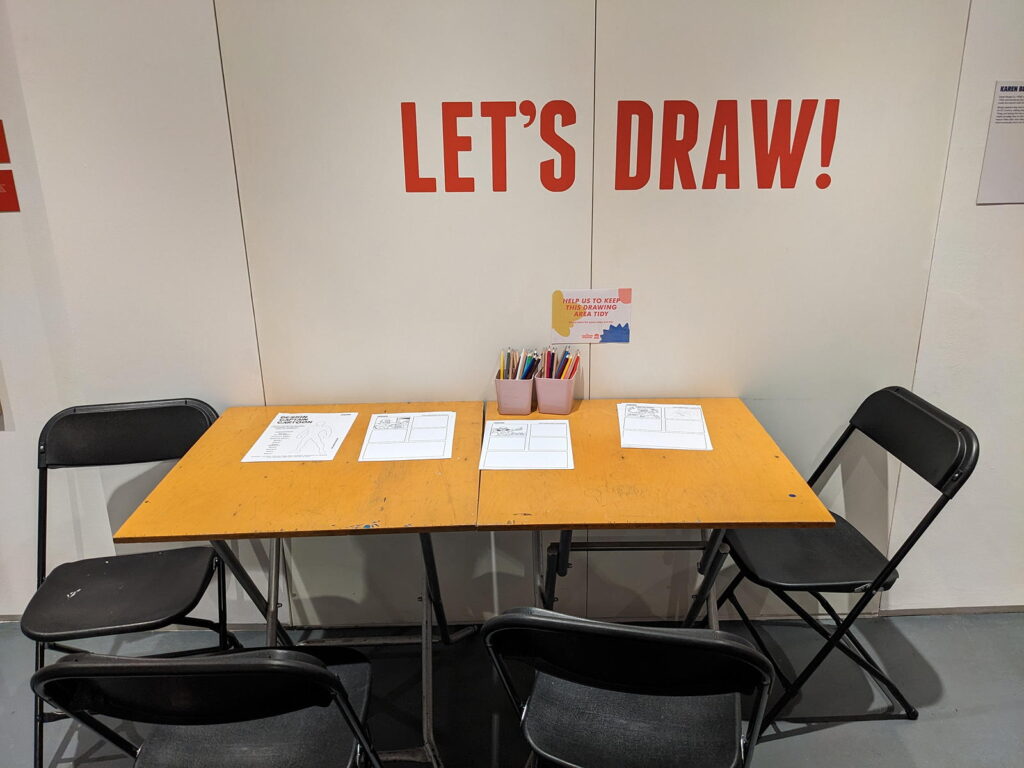
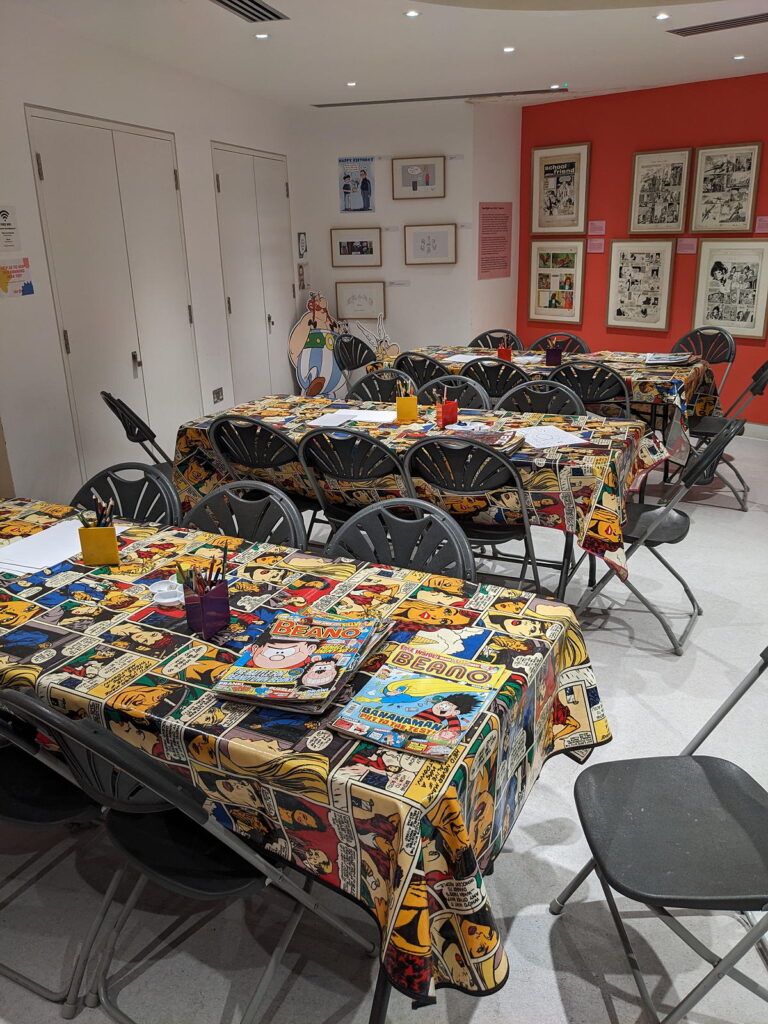
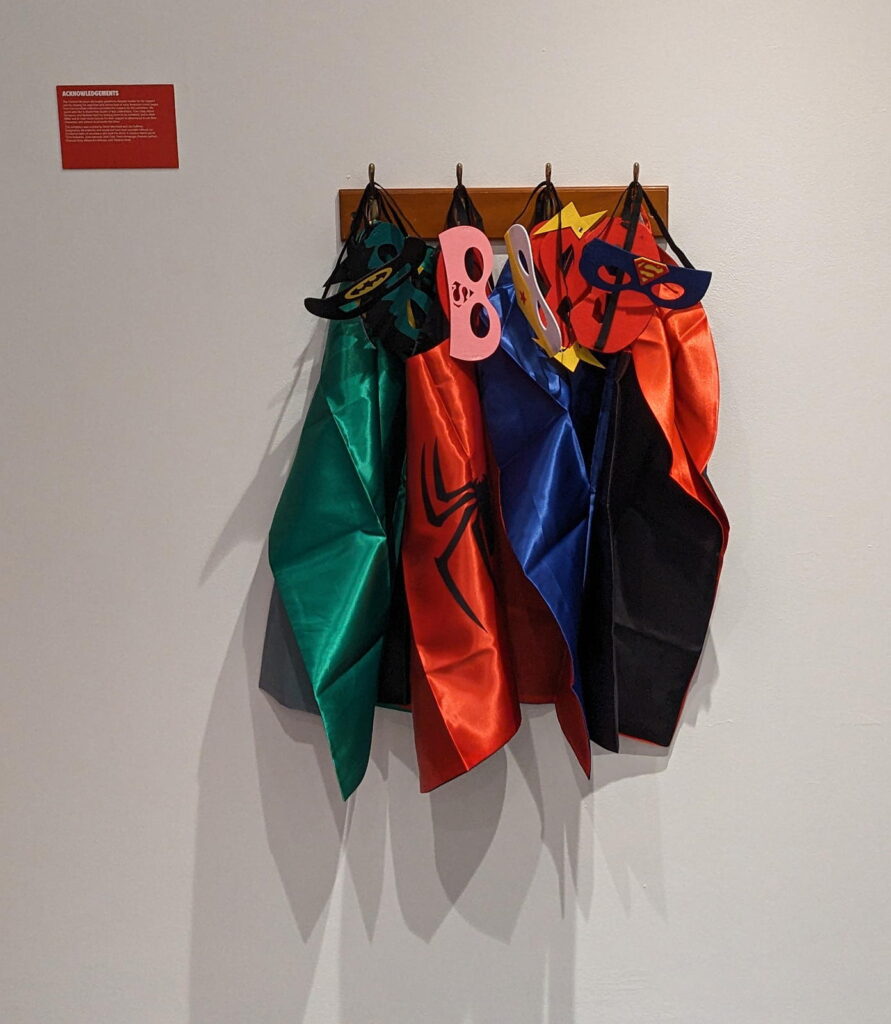
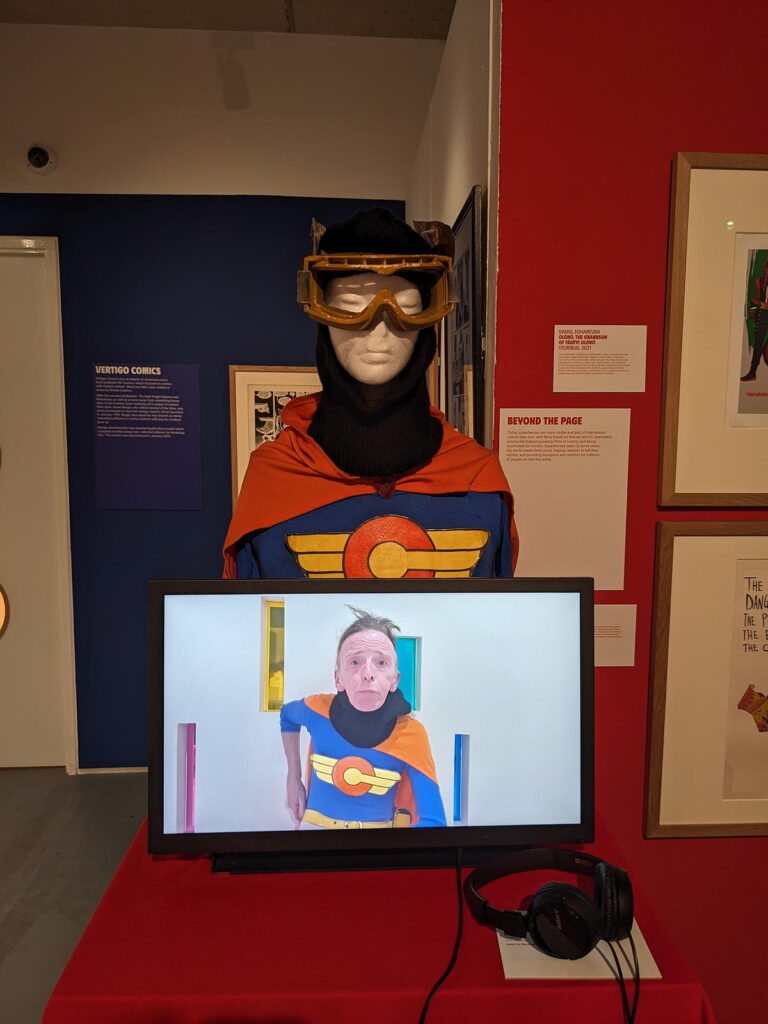
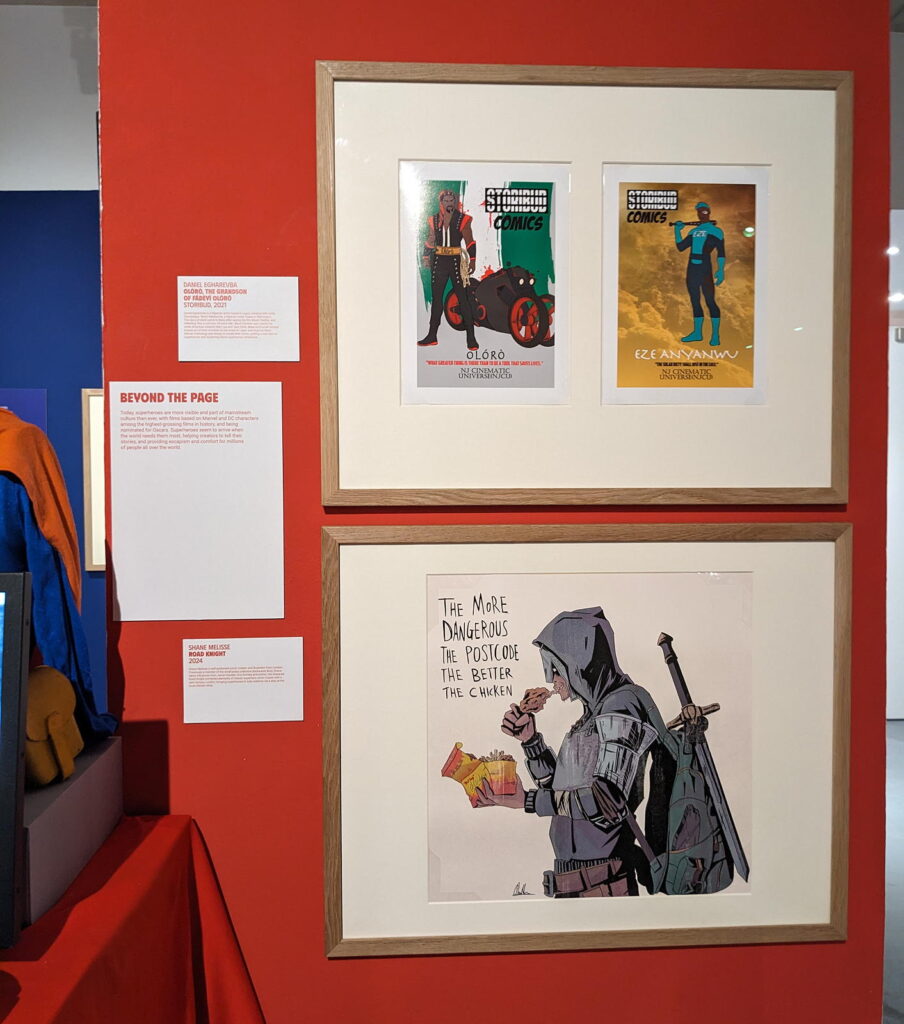
The exhibit shares history and allows the viewer not only to reflect on the beauty of many of these pieces, but also the challenges, tropes, and stereotypes. With 76 original pieces of art on display, 34 comics and newspapers, and five artefacts, there is a considerable amount to enjoy.
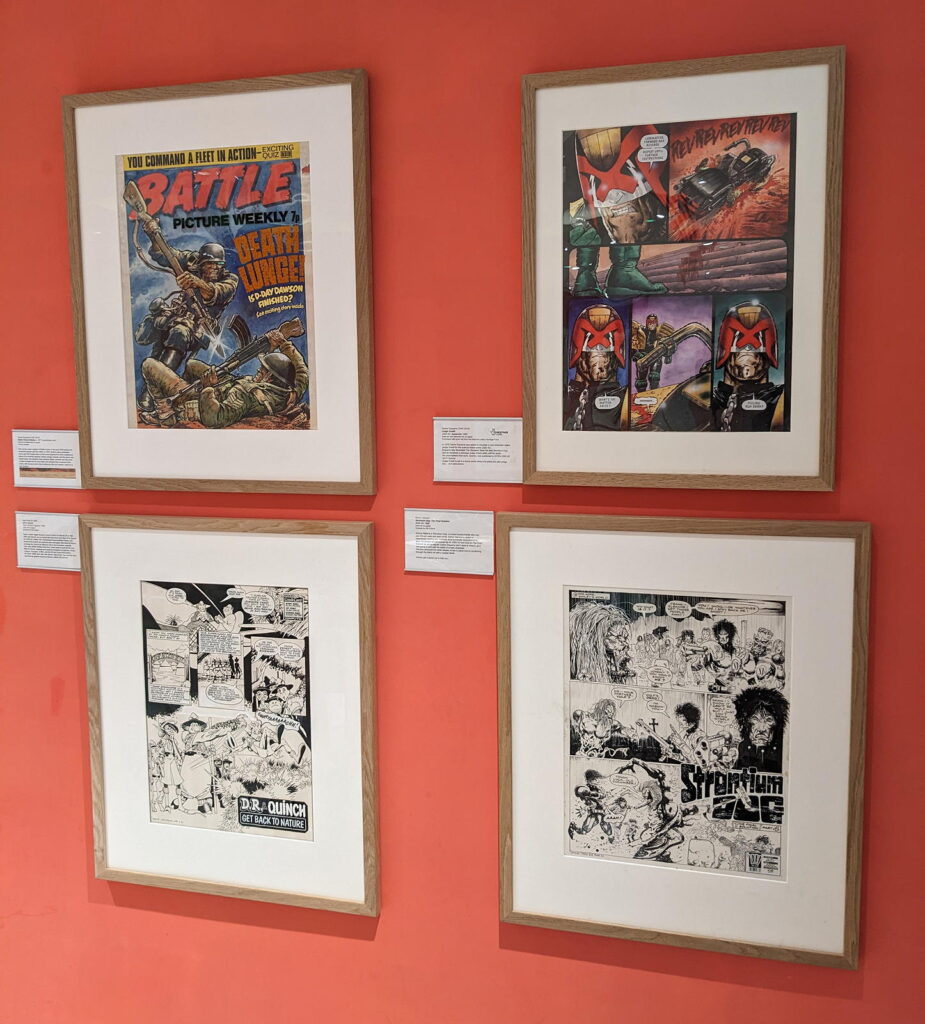
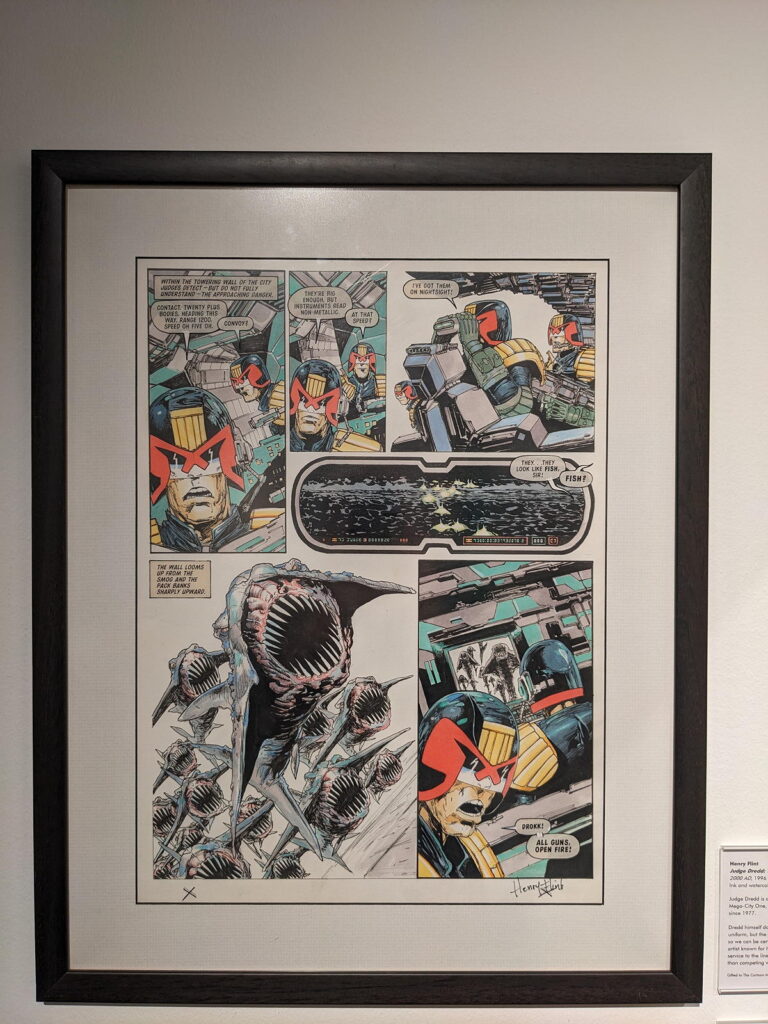
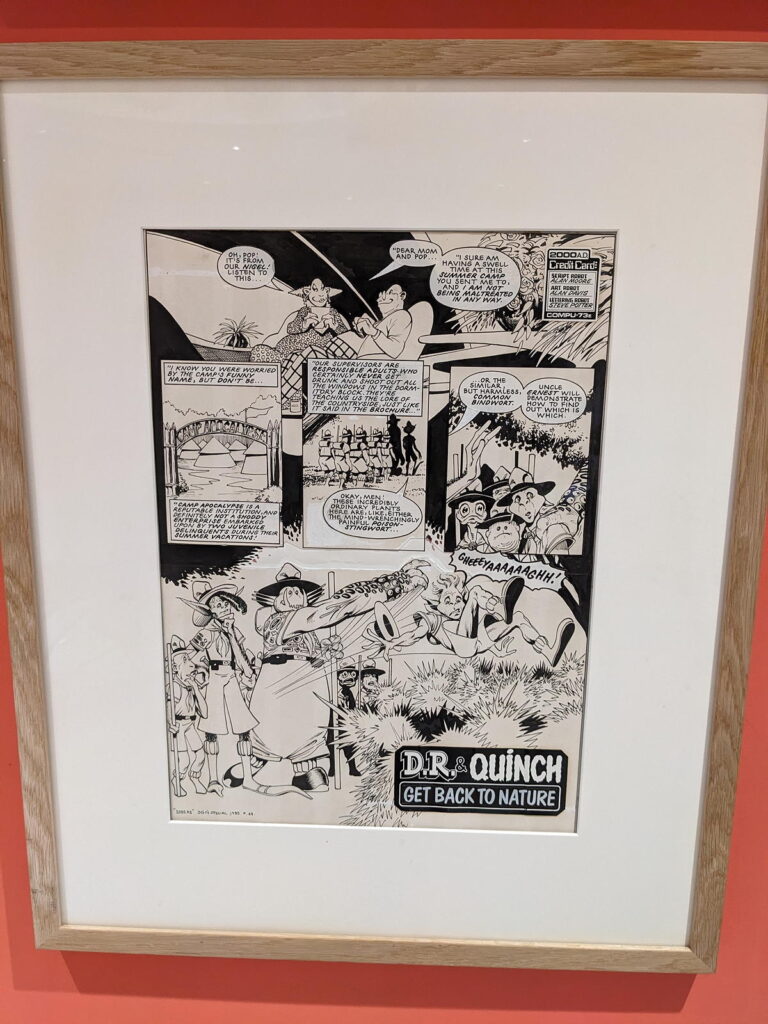
I took a few moments to look around the rest of the Museum. The cartoons have changed since my last visit, although it is amazing to consider that satirical work from decades past can resonate so hard with what is occurring today. There is also further comic art to be found: Carlos Ezquerra and Henry Flint’s “Judge Dredd” pages, Simon Harrison’s “Strontium Dog“, Teenage Mutant Ninja Turtles, and a page from “D.R. and Quinch” by Alan Davis.
Overall, a really very entertaining and informative exhibition which does celebrate with some wonderful art, the British Invasion. A delight to see.
James Bacon
Many thanks to Joe and Steve from the Museum for facilitating James’ visit
• HEROES: The British Invasion of American Comics | Thursday 25th April until Saturday 19th Oct 2024, The Cartoon Museum, 63 Wells Street, Fitzrovia, London, W1A 3AE Tel: 0207 580 8155 | Web: www.cartoonmuseum.org | Facebook | Instagram | Twitter | YouTube
James Bacon (he/him) is an Irish fan, a train driver living in London. A Hugo Award-winning editor of the fanzine “Journey Planet”, he is a comic fan and enjoys comic art, war Comics, Star Wars, Irish aspects to comics and railways in comics or otherwise. He has been writing about comics for over thirty years.
Categories: 2000AD, Art and Illustration, British Comics, Comic Art, Comics, downthetubes Comics News, downthetubes News, Events, Exhibitions, Other Worlds, US Comics